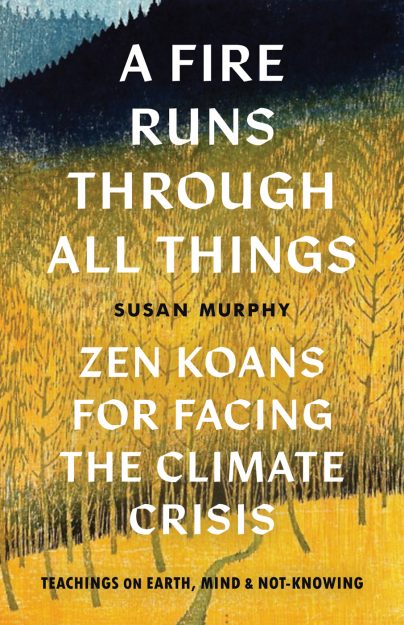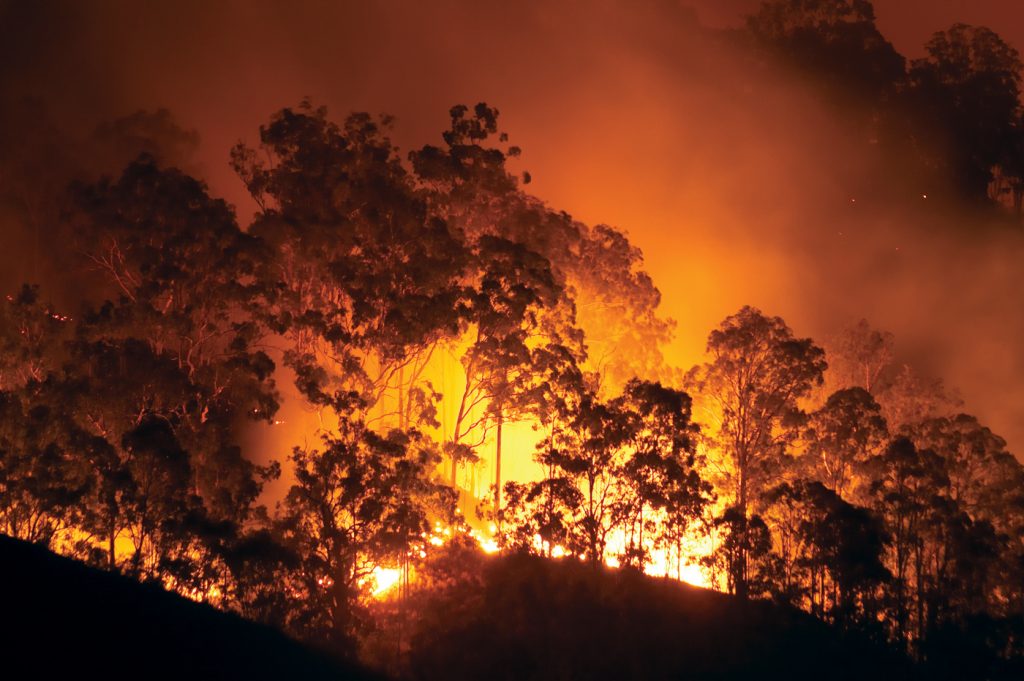The small town where I live in northern California has been designated a “Zone Ten,” which is the highest possible rating for wildfire danger. A few years ago, a swirling sea of flames burned much of the town and came very close to my house. Since then, many neighbors have sold their houses and moved to less woodsy places, and several of my friends believe I should do the same. “Don’t let yourself get trapped,” they say. But I love where I live. And so I feel paralyzed—alternating between long stretches of lulled numbness and brief episodes of high anxiety.
A Fire Runs Through All Things: Zen Koans for Facing the Climate Crisis
By Susan Murphy
Shambhala Publications, November 2023, 248 pp., $21.95, paper
This paralyzed, polarized state is precisely the state that Susan Murphy is speaking to in her new book A Fire Runs Through All Things. She is a Zen teacher in Australia, another part of the world with a radically vulnerable relationship to fire. She teaches in the Zen koan tradition, and the book is both a meditation on the tradition itself and an offering of koans that she has chosen to help us live as fully and dynamically as possible in the face of environmental catastrophe.
What? With a wall of flames on one side and a rising sea on the other, you’re going to ask me if a dog has buddhanature? The answer is an emphatic YES, and for Susan Murphy, the bridge that links the koan tradition and our current climatic condition is the principle of not-knowing. She writes, “The not-knowing mind that koans bring alive is keenly adapted to uncertainty, intimate with impasse, and adept at moving through apparent obstacle. The degree of natural affinity between koans and crisis can be placed in the service of the deep adaptation the world needs to find in this time of convulsive change. The not-knowing mind that is needed to open up koans also opens a treasure of resources for facing the climate crisis.”
Most koans (the word derives from the Chinese words for “public” and “case”) are the verbal record of actual experiences, encounters, and epiphanies that people had in the past, and that seekers in the present are invited to enter and make new for themselves. As Murphy explains, the tradition arose in 8th-century China, in the aftermath of a period of extreme chaos and violence, during which millions of people lost their lives to war, starvation, and disease. She writes, “What later became known as Zen’s treasury of koans could reasonably be compared to a rising immune response and potent medicine for a time of disintegration and collapse. . . . Each koan is an open offer to share the benefaction of the mind that sees emptiness, which runs like fire through all things, including you and me. And to see that which is timeless, formless, unborn, and ablaze in each particle of matter, in each moment, is us . . . ”
As I read the book, I was often reminded of Dogen, the 13th-century Zen master who said, “You must train as if your hair was on fire.” This quality of urgency pervades every page and seems inextricable from the book’s other most striking quality: its out-in-the-openness. Traditionally, koans are held rather close to the chest between Zen teachers and their students. At the Rochester Zen Center, where I studied for several years (and which shares a common Japanese lineage with Susan Murphy’s mentors), students didn’t talk to one another about the koans they were working on. A teacher might give a talk based on a koan, but it was understood that listening to such commentary was utterly different from actually working on a koan in meditation and in private interaction with your teacher. There was the feeling that if you spoke about a koan in a way that was too open or too casual, you risked dissipating the energy to fully penetrate its core.
Certainly, other Zen masters before Susan Murphy have written about koans in a welcoming and exoteric way—most notably her own teacher, John Tarrant, in his Bring Me the Rhinoceros. Still, I found something remarkably intimate about the way that she shares her knowledge and experience of koans. For one thing, she interweaves vivid scenes from her own early life in a way that makes clear that the koan tradition is not an exotic artifact from distant lands in distant times. It actually belongs to a dimension of reality that a barefoot girl of 7 might have discovered in her schoolyard, brushing past prickly plants on her way to the toilet. “Abruptly, suspended in vast, dark space, I found myself blazing, a body of radiance, pouring out in fathomless darkness. Later, I’d compare it to being ‘like a star,’ because what else comes close? But this vast state contained no name, object, subject, gap, or difference anywhere else in the universe. And this also was me. Like nothing else at all.”
Throughout, I felt that Susan Murphy was offering a transfusion of vibrantly alert energy.
Even more than these seamlessly woven-in scenes from her own early life, for me it was the no-time-to-lose, nothing-held-back quality that created the startling intimacy. Throughout, I felt that Susan Murphy was offering a transfusion of vibrantly alert energy. It’s an energy that is palpable in the very texture of her writing, in much the same way that Van Gogh’s brushstrokes convey a life force that swirls through every cloud, field, and flower. And it’s an energy for which she makes herself a conduit, just as others—the old Taoist and Zen masters, her own teachers, her students—have been and are for her.
In the book’s opening pages, Murphy expresses gratitude for the man she describes as her “indigenous Elder,” who showed her “unstinting and unhesitating generosity in sharing the mind of Country and the wisdom of the Dreaming with me across the decades.” In its passionate reverence for the specificity of place and its acute listening to the stories told by all things—not just humans and animals but plants, rocks, mountains, and stars—there is indeed a shamanic vein that runs throughout this book, and that seems utterly at home in its Zen flesh and bones. Like a natural healer offering us precisely which herbs for which illness, she draws from her medicine bag a series of koans that she believes are the best possible medicine in the face of a collapsing planet.
All in all, it’s hard to imagine an elixir more potent for facing the terror of climate disaster.
If you were to distill a single medicine from this gathering of koans, you would find that—along with its central flavor of not-knowing—it tasted of three essential qualities. There is emptiness, the realization that all forms arise from and return to formlessness. Oneness, the realization that all things, animate and inanimate, partake of the same essence in their relation to emptiness. And awakeness, the full and embodied realization that the time to say yes to emptiness and to oneness is always none other than now. Shot through all these qualities is one that stopped the little barefoot girl in her tracks: wonder. It is this quality that keeps the book’s urgency from ever becoming frantic or panicked, because it always finds time to stop and smell the flowers. All in all, it’s hard to imagine an elixir more potent for facing the terror of climate disaster.
Blah blah blah, is what Greta Thunberg, our young prophet of planetary doom, now says in response to the endless proposals, treaties, and resolutions that come out of the various conferences and convergences addressing climate crisis around the globe. Just like the young people who are fed up with “prayers and promises” about gun violence, she wants deeds, not words. But is it possible that there is a form of communication that exists in the gulf between the two?
On my own path, I never felt I had a natural gift for koans the way some people do. It seemed to either take me forever—or no time at all—to discover a response that rang true, so that I never really discovered the how of dancing with them. But what I did experience, again and again, was that when an authentic response came out of me, it was never that I was referring to something “out there” but that I was fully present, fully inhabiting whatever state I was expressing through words and/or movement.
“Words can also be deeds,” the philosopher Ludwig Wittgenstein said. And I do believe this is true of the words in A Fire Runs Through All Things—not only in the koans themselves but also in Susan Murphy’s writing about the koans.
It’s not a book that’s going to offer you “365 Ways to Save the Planet,” with practical tips on how to reduce your carbon footprint. But in finding a way through numbness and acute anxiety, it sparks the state from which creative solutions to extreme crisis are much more likely to come: whether longer-term solutions like “sponge cities” to absorb the ever-increasing floodwaters of our warming planet, or the heartbreakingly stopgap measure of helicopters sending a rain of carrots and apples down on the koalas, kangaroos, wombats, and other starving animals in a scorched Australia.
Sitting in my armchair in a Zone Ten in California, there were moments when I felt that I wasn’t so much reading the book as inhaling it, like a kind of oxygen coming toward me through thousands of miles of thick smoke.

Thank you for subscribing to Tricycle! As a nonprofit, we depend on readers like you to keep Buddhist teachings and practices widely available.
